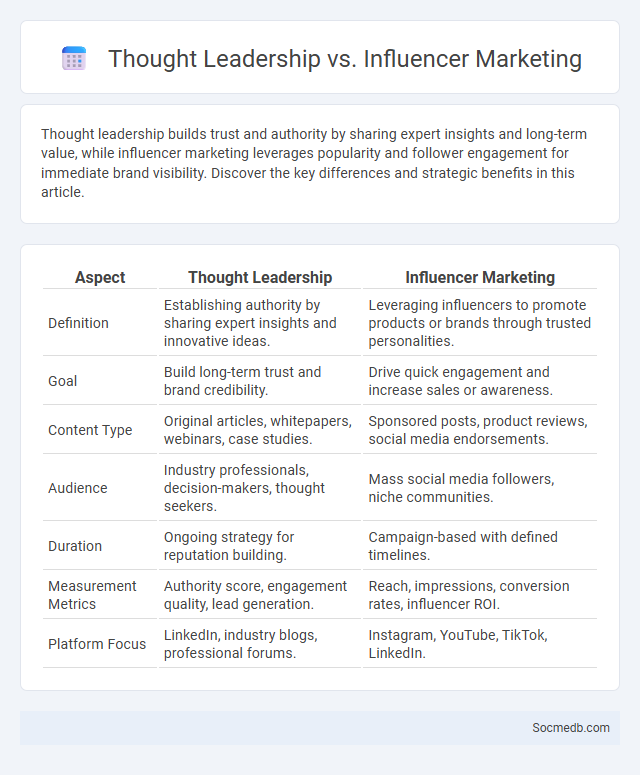
Photo illustration: Thought Leadership vs Influencer Marketing
Thought leadership builds trust and authority by sharing expert insights and long-term value, while influencer marketing leverages popularity and follower engagement for immediate brand visibility. Discover the key differences and strategic benefits in this article.
Table of Comparison
| Aspect | Thought Leadership | Influencer Marketing |
|---|---|---|
| Definition | Establishing authority by sharing expert insights and innovative ideas. | Leveraging influencers to promote products or brands through trusted personalities. |
| Goal | Build long-term trust and brand credibility. | Drive quick engagement and increase sales or awareness. |
| Content Type | Original articles, whitepapers, webinars, case studies. | Sponsored posts, product reviews, social media endorsements. |
| Audience | Industry professionals, decision-makers, thought seekers. | Mass social media followers, niche communities. |
| Duration | Ongoing strategy for reputation building. | Campaign-based with defined timelines. |
| Measurement Metrics | Authority score, engagement quality, lead generation. | Reach, impressions, conversion rates, influencer ROI. |
| Platform Focus | LinkedIn, industry blogs, professional forums. | Instagram, YouTube, TikTok, LinkedIn. |
Understanding Thought Leadership: Definition and Importance
Thought leadership is the practice of positioning an individual or brand as an authority within a specific industry by consistently sharing insightful, original content that addresses key challenges and trends. In social media, thought leadership drives engagement, builds trust, and enhances brand reputation by providing valuable expertise that resonates with target audiences. Establishing thought leadership fosters meaningful connections, increases influence, and opens opportunities for collaboration and growth in competitive digital landscapes.
What is Influencer Marketing?: Key Concepts
Influencer marketing involves collaborating with individuals who have a substantial and engaged following on social media platforms such as Instagram, YouTube, and TikTok to promote products or services. These influencers leverage their credibility and audience trust to drive brand awareness, engagement, and sales through authentic content creation. Key concepts include audience demographics, influencer reach, engagement rate, and the alignment between the influencer's niche and the brand's target market.
Thought Leadership vs Influencer Marketing: Core Differences
Thought leadership centers on establishing Your brand as an authority by sharing valuable insights and expertise, fostering long-term trust and credibility within your industry. Influencer marketing relies on leveraging popular social media personalities to promote products or messages, often aiming for immediate engagement and broad reach. Understanding these core differences helps tailor strategies to either build sustained influence or drive rapid audience interaction.
Goals and Objectives: Setting the Right Intentions
Achieving success on social media requires clearly defined goals and objectives that align with your brand's mission and target audience. Your goals should be specific, measurable, achievable, relevant, and time-bound (SMART) to track progress effectively. Setting the right intentions directs your content strategy, engagement efforts, and advertising campaigns toward meaningful and impactful outcomes.
Audience Engagement: Building Trust and Authority
Audience engagement on social media relies on consistently delivering valuable content that resonates with your followers, fostering authentic interactions that build trust and credibility. By responding promptly to comments and messages, you demonstrate attentiveness and commitment, reinforcing your authority within your niche. Your ability to create meaningful connections encourages repeat engagement, strengthening brand loyalty and expanding your influence.
Content Strategies: Insights vs Endorsements
Content strategies on social media pivot around leveraging insights and endorsements to maximize audience engagement and brand credibility. Insights-driven content capitalizes on data analytics, user behavior, and trending topics to craft relevant, value-packed posts that resonate with target demographics. Endorsements, often through influencer partnerships and user-generated content, amplify trust and authenticity, encouraging conversions and long-term loyalty.
Long-term Value: Sustainability and Impact
Sustainable social media strategies prioritize creating long-term value by fostering authentic engagement and building trust with target audiences. Brands that consistently deliver meaningful content and nurture community relationships achieve lasting impact and enhanced reputation over time. Measuring ongoing customer loyalty and brand advocacy reflects the true sustainability of social media efforts beyond short-term metrics.
Measuring Success: KPIs for Each Approach
Measuring success on social media requires tracking key performance indicators (KPIs) specific to your chosen strategy, such as engagement rate, follower growth, and conversion rate for content marketing. For paid advertising campaigns, focus on click-through rate (CTR), cost per acquisition (CPA), and return on ad spend (ROAS) to evaluate effectiveness. Monitoring these KPIs allows you to optimize your social media efforts and maximize your overall ROI.
Integrating Thought Leadership and Influencer Marketing
Integrating thought leadership with influencer marketing amplifies your brand's authority and reach by leveraging experts who create valuable, insightful content while connecting with engaged audiences. This strategy boosts credibility and drives authentic engagement, positioning your brand as a trusted voice in your industry. By aligning your campaigns with influential thought leaders, you effectively influence purchasing decisions and foster long-term customer loyalty.
Choosing the Right Path: Which Works Best for Your Brand?
Choosing the right social media platform is crucial for maximizing your brand's visibility and engagement. Platforms like Instagram and TikTok excel at visual storytelling and reaching younger audiences, while LinkedIn is ideal for B2B connections and professional content. Understanding your target demographic and brand goals helps you tailor content strategies that resonate effectively with Your audience.
 socmedb.com
socmedb.com